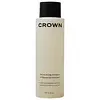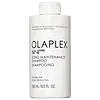What's inside
What's inside
 Key Ingredients
Key Ingredients

 Benefits
Benefits

 Concerns
Concerns

 Ingredients Side-by-side
Ingredients Side-by-side

Water
Skin ConditioningCocamidopropyl Hydroxysultaine
CleansingSodium Cocoyl Isethionate
CleansingSodium C14-16 Olefin Sulfonate
CleansingSodium Laurylglucosides Hydroxypropylsulfonate
CleansingSodium Chloride
MaskingCamellia Japonica Seed Oil
EmollientLimnanthes Alba Seed Oil
Skin ConditioningHydrolyzed Rice Protein
Skin ConditioningSodium Hyaluronate
HumectantPanthenol
Skin ConditioningCoconut Acid
CleansingParfum
MaskingSorbitan Oleate Decylglucoside Crosspolymer
CleansingCocamide Mipa
EmulsifyingHydroxyacetophenone
Antioxidant1,2-Hexanediol
Skin ConditioningCaprylyl Glycol
EmollientPolyquaternium-39
Sodium Isethionate
CleansingTetrasodium Glutamate Diacetate
Polyquaternium-10
Cocamidopropyl Dimethylamine
EmulsifyingSodium Benzoate
MaskingSodium Hydroxide
BufferingBenzyl Alcohol
PerfumingPotassium Sorbate
PreservativeTetramethyl Acetyloctahydronaphthalenes
MaskingLimonene
PerfumingJuniperus Virginiana Oil
MaskingLinalyl Acetate
MaskingLinalool
PerfumingPinene
MaskingWater, Cocamidopropyl Hydroxysultaine, Sodium Cocoyl Isethionate, Sodium C14-16 Olefin Sulfonate, Sodium Laurylglucosides Hydroxypropylsulfonate, Sodium Chloride, Camellia Japonica Seed Oil, Limnanthes Alba Seed Oil, Hydrolyzed Rice Protein, Sodium Hyaluronate, Panthenol, Coconut Acid, Parfum, Sorbitan Oleate Decylglucoside Crosspolymer, Cocamide Mipa, Hydroxyacetophenone, 1,2-Hexanediol, Caprylyl Glycol, Polyquaternium-39, Sodium Isethionate, Tetrasodium Glutamate Diacetate, Polyquaternium-10, Cocamidopropyl Dimethylamine, Sodium Benzoate, Sodium Hydroxide, Benzyl Alcohol, Potassium Sorbate, Tetramethyl Acetyloctahydronaphthalenes, Limonene, Juniperus Virginiana Oil, Linalyl Acetate, Linalool, Pinene
Water
Skin ConditioningSodium Cocoyl Alaninate
Sodium Cocoyl Isethionate
CleansingCoco-Glucoside
CleansingLauryl Glucoside
CleansingPropanediol
SolventCocamidopropyl Hydroxysultaine
CleansingGlycerin
HumectantAcrylates Copolymer
Polyquaternium-80
CleansingBis-Aminopropyl Diglycol Dimaleate
Skin ConditioningPhenoxyethanol
PreservativeSodium Chloride
MaskingParfum
MaskingCoconut Acid
CleansingCocamide Mipa
EmulsifyingGuar Hydroxypropyltrimonium Chloride
Skin ConditioningPolyglyceryl-4 Caprate
EmulsifyingPolyglyceryl-6 Caprylate
EmulsifyingPolyimide-1
Chlorphenesin
AntimicrobialPanthenol
Skin ConditioningXanthan Gum
EmulsifyingPolyquaternium-7
Cetrimonium Chloride
AntimicrobialEthylhexylglycerin
Skin ConditioningOryza Sativa Bran Extract
Skin ConditioningHydrolyzed Quinoa
Skin ConditioningTrisodium Ethylenediamine Disuccinate
Sarcosine
Skin ConditioningPisum Sativum Seed Extract
Skin ConditioningHelianthus Annuus Extract
EmollientPropylene Glycol
HumectantSclerotium Gum
Emulsion Stabilising1,2-Hexanediol
Skin ConditioningRosmarinus Officinalis Leaf Extract
AntimicrobialTocopherol
AntioxidantSodium Hydroxide
BufferingAlgin
MaskingSodium Hyaluronate
HumectantSodium Benzoate
MaskingBenzyl Alcohol
PerfumingTetrasodium Glutamate Diacetate
Potassium Sorbate
PreservativeCaesalpinia Spinosa Fruit Extract
Skin ProtectingHelianthus Annuus Sprout Extract
Skin ConditioningCitric Acid
BufferingHexyl Cinnamal
PerfumingLimonene
PerfumingCitral
PerfumingCI 19140
Cosmetic ColorantCI 15985
Cosmetic ColorantWater, Sodium Cocoyl Alaninate, Sodium Cocoyl Isethionate, Coco-Glucoside, Lauryl Glucoside, Propanediol, Cocamidopropyl Hydroxysultaine, Glycerin, Acrylates Copolymer, Polyquaternium-80, Bis-Aminopropyl Diglycol Dimaleate, Phenoxyethanol, Sodium Chloride, Parfum, Coconut Acid, Cocamide Mipa, Guar Hydroxypropyltrimonium Chloride, Polyglyceryl-4 Caprate, Polyglyceryl-6 Caprylate, Polyimide-1, Chlorphenesin, Panthenol, Xanthan Gum, Polyquaternium-7, Cetrimonium Chloride, Ethylhexylglycerin, Oryza Sativa Bran Extract, Hydrolyzed Quinoa, Trisodium Ethylenediamine Disuccinate, Sarcosine, Pisum Sativum Seed Extract, Helianthus Annuus Extract, Propylene Glycol, Sclerotium Gum, 1,2-Hexanediol, Rosmarinus Officinalis Leaf Extract, Tocopherol, Sodium Hydroxide, Algin, Sodium Hyaluronate, Sodium Benzoate, Benzyl Alcohol, Tetrasodium Glutamate Diacetate, Potassium Sorbate, Caesalpinia Spinosa Fruit Extract, Helianthus Annuus Sprout Extract, Citric Acid, Hexyl Cinnamal, Limonene, Citral, CI 19140, CI 15985
Ingredients Explained
These ingredients are found in both products.
Ingredients higher up in an ingredient list are typically present in a larger amount.
1,2-Hexanediol is a synthetic liquid and another multi-functional powerhouse.
It is a:
- Humectant, drawing moisture into the skin
- Emollient, helping to soften skin
- Solvent, dispersing and stabilizing formulas
- Preservative booster, enhancing the antimicrobial activity of other preservatives
Benzyl Alcohol is most commonly used as a preservative. It also has a subtle, sweet smell. Small amounts of Benzyl Alcohol is not irritating and safe to use in skincare products. Most Benzyl Alcohol is derived from fruits such as apricots.
Benzyl Alcohol has both antibacterial and antioxidant properties. These properties help lengthen the shelf life of products. Benzyl Alcohol is a solvent and helps dissolve other ingredients. It can also improve the texture and spreadability.
Alcohol comes in many different forms. Different types of alcohol will have different effects on skin. This ingredient is an astringent alcohol.
Using high concentrations of these alcohols are drying on the skin. They may strip away your skin's natural oils and even damage your skin barrier. Astringent alcohols may also irritate skin.
Other types of astringent alcohols include:
According to the National Rosacea Society based in the US, you should be mindful of products with these alcohols in the top half of ingredients.
Any type of sanitizing product will have high amounts of alcohol to help kill bacteria and viruses.
Learn more about Benzyl AlcoholWe don't have a description for Cocamide Mipa yet.
Cocamidopropyl Hydroxysultaine is a synthetic cleansing agent, though it is derived from coconut oil.
It is used to enhance the texture of products by boosting lather and thickening the texture. As a cleanser, Cocamidopropyl Hydroxysultaine is mild.
Coconut Acid isn't fungal acne safe.
Limonene is a fragrance that adds scent and taste to a formulation.
It's found in the peel oil of citrus fruits and other plants such as lavender and eucalyptus. The scent of limonene is generally described as "sweet citrus".
Limonene acts as an antioxidant, meaning it helps neutralize free radicals.
When exposed to air, oxidized limonene may sensitize the skin. Because of this, limonene is often avoided by people with sensitive skin.
The term 'fragrance' is not regulated in many countries. In many cases, it is up to the brand to define this term. For instance, many brands choose to label themselves as "fragrance-free" because they are not using synthetic fragrances. However, their products may still contain ingredients such as essential oils that are considered a fragrance.
Learn more about LimonenePanthenol is a common ingredient that helps hydrate and soothe the skin. It is found naturally in our skin and hair.
There are two forms of panthenol: D and L.
D-panthenol is also known as dexpanthenol. Most cosmetics use dexpanthenol or a mixture of D and L-panthenol.
Panthenol is famous due to its ability to go deeper into the skin's layers. Using this ingredient has numerous pros (and no cons):
Like hyaluronic acid, panthenol is a humectant. Humectants are able to bind and hold large amounts of water to keep skin hydrated.
This ingredient works well for wound healing. It works by increasing tissue in the wound and helps close open wounds.
Once oxidized, panthenol converts to pantothenic acid. Panthothenic acid is found in all living cells.
This ingredient is also referred to as pro-vitamin B5.
Learn more about PanthenolParfum is a catch-all term for an ingredient or more that is used to give a scent to products.
Also called "fragrance", this ingredient can be a blend of hundreds of chemicals or plant oils. This means every product with "fragrance" or "parfum" in the ingredients list is a different mixture.
For instance, Habanolide is a proprietary trade name for a specific aroma chemical. When used as a fragrance ingredient in cosmetics, most aroma chemicals fall under the broad labeling category of “FRAGRANCE” or “PARFUM” according to EU and US regulations.
The term 'parfum' or 'fragrance' is not regulated in many countries. In many cases, it is up to the brand to define this term.
For instance, many brands choose to label themselves as "fragrance-free" because they are not using synthetic fragrances. However, their products may still contain ingredients such as essential oils that are considered a fragrance by INCI standards.
One example is Calendula flower extract. Calendula is an essential oil that still imparts a scent or 'fragrance'.
Depending on the blend, the ingredients in the mixture can cause allergies and sensitivities on the skin. Some ingredients that are known EU allergens include linalool and citronellol.
Parfum can also be used to mask or cover an unpleasant scent.
The bottom line is: not all fragrances/parfum/ingredients are created equally. If you are worried about fragrances, we recommend taking a closer look at an ingredient. And of course, we always recommend speaking with a professional.
Learn more about ParfumPotassium Sorbate is a preservative used to prevent yeast and mold in products. It is commonly found in both cosmetic and food products.
This ingredient comes from potassium salt derived from sorbic acid. Sorbic acid is a natural antibiotic and effective against fungus.
Both potassium sorbate and sorbic acid can be found in baked goods, cheeses, dried meats, dried fruit, ice cream, pickles, wine, yogurt, and more.
You'll often find this ingredient used with other preservatives.
Learn more about Potassium SorbateSodium Benzoate is a preservative. It's used in both cosmetic and food products to inhibit the growth of mold and bacteria. It is typically produced synthetically.
Both the US FDA and EU Health Committee have approved the use of sodium benzoate. In the US, levels of 0.1% (of the total product) are allowed.
Sodium benzoate works as a preservative by inhibiting the growth of bacteria inside of cells. It prevents the cell from fermenting a type of sugar using an enzyme called phosphofructokinase.
It is the salt of benzoic acid. Foods containing sodium benzoate include soda, salad dressings, condiments, fruit juices, wines, and snack foods.
Studies for using ascorbic acid and sodium benzoate in cosmetics are lacking, especially in skincare routines with multiple steps.
We always recommend speaking with a professional, such as a dermatologist, if you have any concerns.
Learn more about Sodium BenzoateChances are, you eat sodium chloride every day. Sodium Chloride is also known as table salt.
This ingredient has many purposes in skincare: thickener, emulsifier, and exfoliator.
You'll most likely find this ingredient in cleansers where it is used to create a gel-like texture. As an emulsifier, it also prevents ingredients from separating.
There is much debate on whether this ingredient is comedogenic. The short answer - comedogenic ratings don't tell the whole story. Learn more about comegodenic ratings here.
The concensus about this ingredient causing acne seems to be divided. Research is needed to understand if this ingredient does cause acne.
Scrubs may use salt as the primary exfoliating ingredient.
Learn more about Sodium ChlorideSodium cocoyl isethionate is a natural ingredient from coconut oil. It is an ultra gentle cleanser that gives a nice foam without drying the skin or impacting the skin barrier.
The amount of foam created depends on the amount of sodium cocoyl isethionate used in the product.
This ingredient also helps improve the spreadability of a product.
Learn more about Sodium Cocoyl IsethionateSodium Hyaluronate is hyaluronic acid's salt form. It is commonly derived from the sodium salt of hyaluronic acid.
Like hyaluronic acid, it is great at holding water and acts as a humectant. This makes it a great skin hydrating ingredient.
Sodium Hyaluronate is naturally occurring in our bodies and is mostly found in eye fluid and joints.
These are some other common types of Hyaluronic Acid:
Learn more about Sodium HyaluronateSodium Hydroxide is also known as lye or caustic soda. It is used to adjust the pH of products; many ingredients require a specific pH to be effective.
In small amounts, sodium hydroxide is considered safe to use. However, large amounts may cause chemical burns due to its high alkaline.
Your skin has a natural pH and acid mantle. This acid mantle helps prevent harmful bacteria from breaking through. The acid mantle also helps keep your skin hydrated.
"Alkaline" refers to a high pH level. A low pH level would be considered acidic.
Learn more about Sodium HydroxideTetrasodium Glutamate Diacetate is a chelating agent. Chelating agents help prevent metal ions from binding to other ingredients. This helps prevent unwanted effects and reactions from a product. These metal ions may come from water and are found in miniscule amounts.
Tetrasodium Glutamate Diacetate can also help other preservatives be more effective.
Water. It's the most common cosmetic ingredient of all. You'll usually see it at the top of ingredient lists, meaning that it makes up the largest part of the product.
So why is it so popular? Water most often acts as a solvent - this means that it helps dissolve other ingredients into the formulation.
You'll also recognize water as that liquid we all need to stay alive. If you see this, drink a glass of water. Stay hydrated!
Learn more about Water